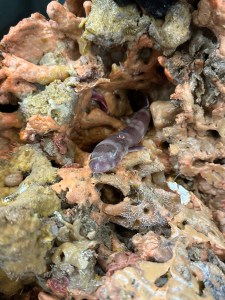
Credit: CSIRO
While onboard the RV Investigator in 2017, scientists collected a large sponge, but that wasn’t the only thing they collected. Inside, they found 30 banded sand catsharks (Atelomycterus fasciatus). This was the first time sharks had been seen living in sponges, but it wasn’t the last.
The 2017 voyage, which surveyed the Dampier and Montebello Marine Parks, saw a further 24 banded sand catsharks found in 2 more sponges. Meanwhile a 2022 voyage to the Gascoyne and Carnarvon Canyon Marine Parks found another 3 sharks in 2 sponges. This makes a grand total of 57 banded sand catsharks found in 5 sponges!
You might be wondering how so many sharks could fit in a sponge. Well firstly, the sponges are quite large. They belong to the Irciniidae and Agelasidae families. These sponges have many folds and crevices and some of those collected measured around 1 metre across. Secondly, the banded sand catsharks are small. The sharks found in the sponges, which were both males and females of various ages, ranged in length from 12 to 39 centimetres.
While scientists have observed fish using sponges as microhabitats, this is a first for any elasmobranch (sharks, rays, skates and sawfish). Dr Will White, a CSIRO researcher who was onboard the 2022 voyage, says, “clearly this species is seeking protection given the sheer number that have been observed in just a single sponge – likely from the many larger predators which frequent these waters.”
Banded sand catsharks live on the seafloor at depths between 27-122 metres. They are nocturnal and eat small invertebrates and fish. These sharks are only found off the northwestern coast of Australia but, “the sharks collected last year extended the known distribution of this species 250 kilometres south from where we previously knew it to occur,” says Will.
Most of the 57 catsharks found and their sponge houses were returned alive to the ocean. Small pieces of the sponges and only a few sharks were kept as specimens for continued scientific research.
